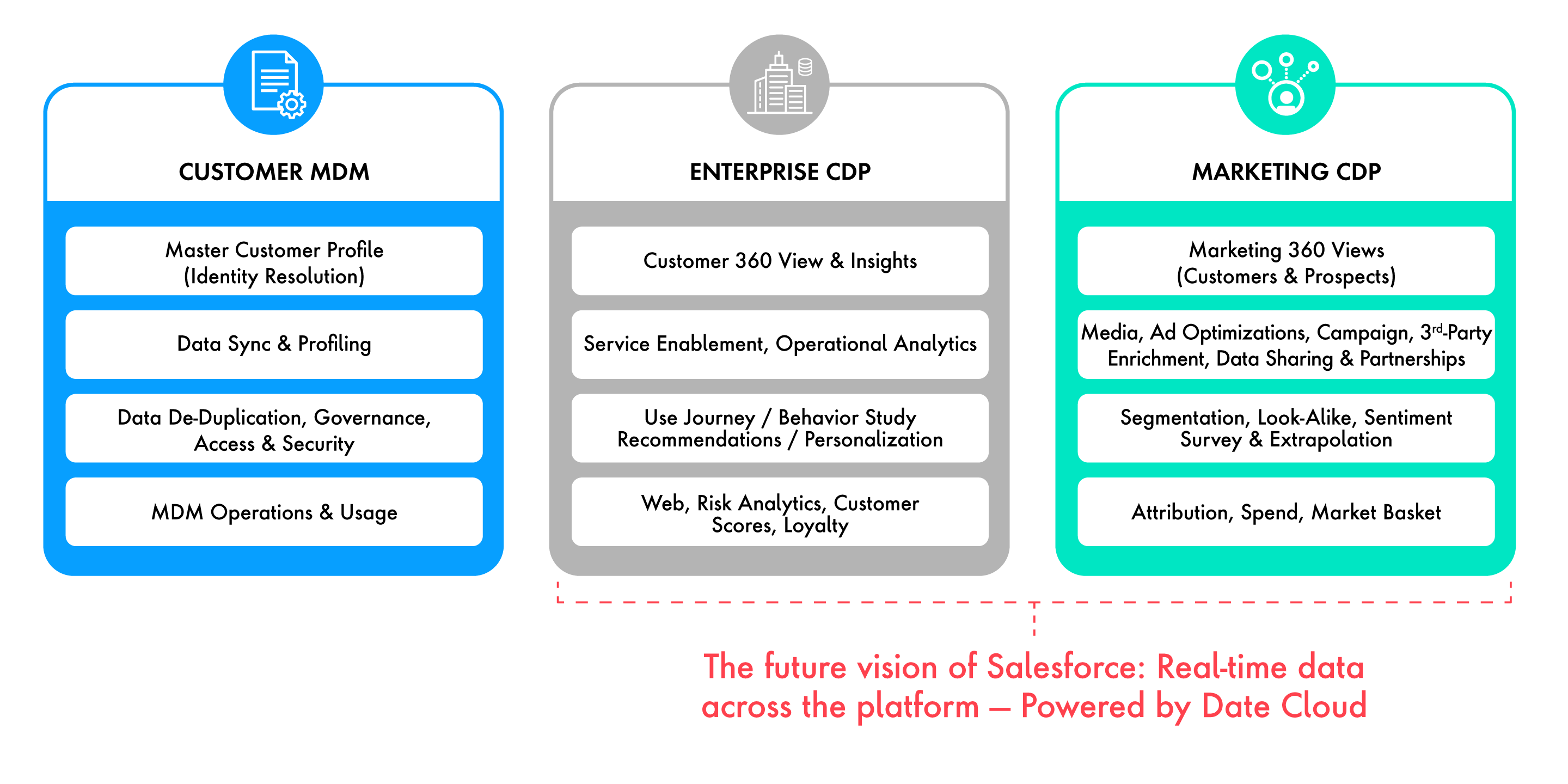What issue can we solve for you?
Type in your prompt above or try one of these suggestions
Suggested Prompt



Insight
Building Customer 360 with Salesforce Data Cloud — Part 1
Building Customer 360 with Salesforce Data Cloud — Part 1
CDPs are the central enabling mechanism that drive omnichannel customer experiences.
A CDP is about more than marketing.
Publicis Sapient has more than 10 years of CDP experience. Along the way, we’ve encountered many definitions (and misconceptions) of CDPs framed by thought leaders, consulting firms, analysts and software providers.
A common misconception is that Customer Data Platforms are focused on marketing and, therefore, only for marketers. However, it is probably more accurate to frame CDPs as being about delivering the data, decisions and activations needed to inform an experience. We could even talk about CDPs in the context of risk management. But in any case, it is about bringing the data surrounding a customer together so a business can make a more informed, actionable decision. And marketers have, by default, become the most centralized owners of customer experience.
86% of customers say an emotional connection makes them continue doing business with a brand – all influenced by their firsthand experiences.
Now is the time to level set on how we think about CDP.
For us, it is a collection of software with an underlying unified customer database, all working together (as a platform) to drive decisions and activations that inform how we engage with a customer. (Our definition generally aligns with Wikipedia’s.) This is an incredibly important distinction because many software vendors want to drive home that a CDP is just a database and not much more. And while it is a crucial component of the platform — it will not — on its own, magically create the customer experience outcomes you’re hoping for.
Now that we’ve expanded the idea of CDP — more akin to the idea of Salesforce’s Customer 360 branding — let’s go a little further into the different types of CDPs.
These categorizations fall into three primary buckets.
- Customer MDM: This is not a CDP — full stop — although it can unify customer data into a golden record, which may be a critical input to a CDP. An MDM is a different category of software altogether.
- Enterprise CDP: Think of that very expensive data lake IT built several years ago that holds a lot of enterprise and customer data. It may have a lot of the data you need. But often, data lakes lack friendly interfaces and the integrations required to actually make use of the data. Unless you consider “friendly” to be a tech ticket and 2-week wait time to retrieve a segment that you forward to another team to activate. Yes, this does happen. Nonetheless, they do serve a purpose, often in analytics and feeding the Marketing CDP. In fact, if your company built this on Snowflake, then Salesforce’s CDP will soon bolt right onto it, taking advantage of previous investments in data engineering, etc.
- Marketing CDP: This is where most of the energy is right now. While an Enterprise CDP may have much of your customer’s profile and transactional data, you would use the Marketing CDP to augment that with behavioral data, which can be more transient. And the interface is simpler for business users to use, providing segment activation points to systems of engagement, like Salesforce’s Marketing Cloud, Personalization (FKA Interaction Studio), and Service Cloud via Data Cloud, which we’ll cover in another article.

Three types of data platforms. Salesforce is currently a Marketing CDP, but the roadmap will allow it to stretch beyond marketing use-cases.
Currently, Salesforce CDP falls into the bucket of a Marketing CDP. More specifically, it is the underlying database that serves as a data collection component to compile a unified record of each of your customers by capturing data, such as PII, interaction and engagement, transactional and more. However, it is limited in how data moves from collection through activation.
With that as a setup, let’s now explore new heights with Data Cloud.
Salesforce Data Cloud is the newest capability from Salesforce. It will help power the Customer 360 experience by making data in the Salesforce CDP product available to other parts of the Customer 360 platform, as well as external applications, in real time.
We’ll stop there because the next article explains what Salesforce Data Cloud is and what it enables today and in the future. But here’s the bottom line: CDP is a big idea that can get very nuanced. And that’s where we see clients struggle — integrating the big idea with their specific outcomes, technology stack, and use cases. This makes it difficult to know where to start.
To make it easier, we’ve built the CDP Maturity Index — a 60-second self-assessment tool — to help frame where your organization’s capabilities stand today. This tool is a fantastic way to start planning for the future.
Related Reading
-
![]()
Deliver Messaging at Scale with WhatsApp & Salesforce
Publicis Sapient and Salesforce are partnering with Meta to deliver in-the-moment conversational experiences through WhatsApp Business Messaging.
-
![]()
Publicis Sapient’s Value Alignment Lab
An outcome driven discovery workshop focusing on delivering value.
-
![]()
Unlock Real-World Value through Practical AI and Salesforce
Publicis Sapient is partnering with Salesforce and Publicis Sapient AI Labs to help businesses unleash practical AI solutions to solve complex challenges.







